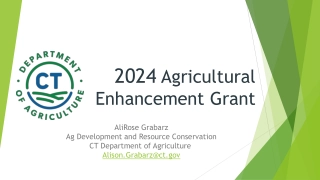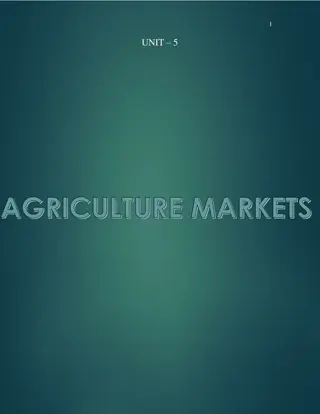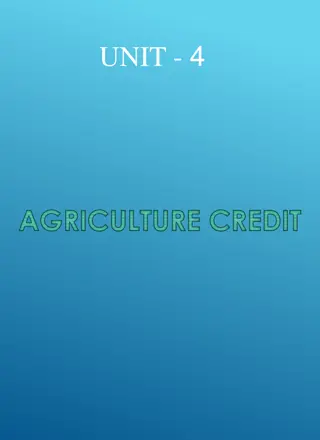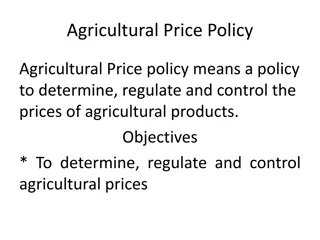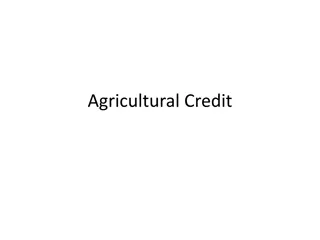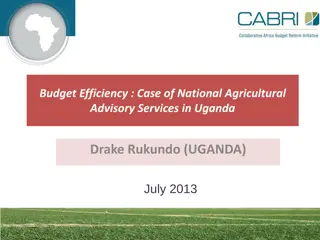Understanding Agricultural Marketing: Concepts and Strategies
Agricultural marketing involves determining consumer preferences, production, sales, and customer retention. Learn about the differences between marketing and selling, the marketing mix, physical functions, and packaging guidelines for fresh produce.
Download Presentation

Please find below an Image/Link to download the presentation.
The content on the website is provided AS IS for your information and personal use only. It may not be sold, licensed, or shared on other websites without obtaining consent from the author. Download presentation by click this link. If you encounter any issues during the download, it is possible that the publisher has removed the file from their server.
E N D
Presentation Transcript
DIRECTORATE CURRICULUM FET PROGRAMMES Agricultural sciences Virtual Revision Paper 2
The concept of marketing 1. Marketing is the process of determining which products the consumer wants 2. How consumer wants these products, 3. Where the consumer wants them, 4. Getting the consumer to buy the product and 5. Keep the consumer coming back for more.
The differences between marketing and selling Marketing Emphasis is on customers wants The farm or agricultural business determines I customers wants, and then decides how to produce I and deliver a product to satisfy those wants Management is profit-oriented Planning Is long-term, based on new products, tomorrow s markets and future growth Focuses on the wants of buyers Selling Emphasis is on the agricultural product The farm or agricultural business produces the product, and then decides how to sell it Management is sales-volume oriented Planning is short-term, based on current products and market Focuses on the needs of seller
The marketing mix The approach that a company takes to marketing its products is called the marketing mix. The marketing mix consists of the four Ps Product Prices Place Promotion
Functions of agricultural marketing, physical functions includes 1. Transportation and handling i.e. rail, road, air and sea 2. Storage. Storage includes holding raw products and supplies of finished products until they are needed. Suitable facilities are required to ensure that the produce does not deteriorate during storage. 3. Processing (value adding and packaging). Most agricultural produce is not in a suitable form for direct delivery to the consumer when it is harvested, and must be changed in some way before it can be consumed. Activities involved include milling (e.g. maize meal). Fermenting (e.g. beer), blending (e.g. fruit juice and milk in certain beverages)
Guidelines for packaging fresh produce Product identification: The package must identify and provide useful information about the produce Recyclability (biodegradability): A growing number of local and international markets have waste disposal restrictions for packaging materials. Containment: The container should enclose the produce in more convenient units for handling and distribution. Protection: The package must protect the produce from mechanical damage and poor environmental conditions during handling and distribution. Health risk: The material used for packaging construction must not contain chemicals that could transfer to the produce and be toxic.
Price determination and demand/supply Demand and supply 1. Demand: can be defined as the amount or quantity of a particular economic good or product or the service that a consumer or group of consumers wants to purchase at a given price. 2. Supply: can be defined as the various quantities of a product that are produced or offered by the sellers at varying prices
The law of demand As the price of a good rises, the quantity demanded of the good falls. As the price of a good falls, the quantity demanded of a good rises. the price of a good and the quantity demanded of the good are inversely related
The interpretation of the demand curve The demand curve is usually downward sloping consumers will want to buy more as the price decreases. The lower the price of the product the more the product will be bought by the consumer, provided that all the other factors that influence the demand remain equal or constant.
The law of supply The supply curve shows the maximum quantities of a product that sellers would offer on a market at different prices per time unit. the supply curve increases upward to the right, because a higher price will result in more of the product being offered on the market and more of the specific product will be produced.
Factors that influence demand Consumer income spending Changes in preferences Research Advertising/Fashion Number of consumers Sociological factors Legislation Price of competing and complementing The range of products available to consumers: Use of the product Price expectation Festive season Substitutes
Factors affecting the supply of a product Cost of labour Natural disasters Input costs Technology Legislation Seasonality Changes in the price of similar goods Political instability Expectations of future price change Demand for the product Possibilities of increasing the supply of goods Subsidies Use of the product.
Price elasticity The extent to which a change in price influences the demand and supply , of a product is called the price elasticity of the product. Products have flexibility in demand in response to a change in price. Elasticity can be calculated as follows: percentage change in demand Elasticity Ed = --------------------------------------- percentage change in price
Concept: Market equilibrium Market equilibrium is when the demand for a product at a specific price is equal to the supply of that product at the same specific price. At this point the demand and supply is balanced and the price is stable.
Type of buyers Retailers Food processing companies Exporters and importers . Brokers Consumer Buyers in more traditional commodities
Methods used to promote products Advertising: Personal selling: Sales promotion: Public relations: Direct marketing: Catalogues Visual tools: brochures, posters and packaging Online directories Use of telecommunication media Business pages of your telephone book Trade fairs and exhibitions: Personal selling:
Types of marketing: 1.Niche marketing Niche marketing focuses on a specific group of consumers in a market place. A niche market is usually a small section of the market, comprising consumers who share a preference and who are willing to pay a premium for a product or service that satisfies that specific preference. A business can create a niche market by: Identifying a shortfall in the products currently available in the market Calculating the degree to which consumers are willing to pay extra . Establishing if there are enough consumers who are willing to do so.
2 Mass marketing Mass marketing reach most consumers than targeting a particular market segment. It targets the whole market with a single offer. Such a strategy is effective only for products such as maize and fruit that appeal to a broad cross-section of consumers. It cannot be used for products with limited appeal. It is generally more expensive than direct marketing. Mass marketing is done through radio, television and newspaper
3 Multi-segment marketing Multi-segment marketing is when the same product is offered to different groups or segments in a market. This is typically done by offering different levels of quality to different levels of income, for example offering Class 1 fruit to consumers with high income and Class 3 fruit to consumers with low income. Advantages and disadvantages of multi-segment marketing An advantage of this type of marketing is that producers will have a market for all their produce. A disadvantage of this type of marketing is that consumers with higher income might opt to buy a lower quality of produce due to its lower price.
Sustainable agricultural marketing . Sustainable agricultural marketing entails adapting activities on every level of operation to be more ecologically friendly and safe, as well as socially acceptable and healthy. The activities on the different levels include the following: Product: developing a product that is naturally healthy, instead of genetically modified crops Changes to production process: using sustainable agricultural practices: Packaging: using recycled or recyclable materials in packaging instead of materials such as plastic. Advertising: aiming to better communicate the sustainable agricultural practices employed in production is called eco-Iabelling.
Agricultural marketing systems: 1 The free-marketing concept A free-market system is where: The general population is free to produce goods and to offer goods for sale to the rest of the population The rest of the population is free to buy these goods The price of goods is determined by demand and supply There is no government intervention in any stage.
Advantages Producers are free to produce what they want and consumers are free to buy what they want. Price is determined by demand and supply. There are no barriers to stop new producers, which leads to better competition. Better competition can lead to better products and better prices. New products and ideas are easily developed. Entrepreneurs have the opportunity to grow their businesses and create wealth. A free-market economy can encourage agricultural production. This contributes to national economic growth and an increase in employment. The products are usually of a high quality. Payment is usually in the form of cash. The middlemen in the marketing I process are limited or eliminated. Free marketing stimulates the entrepreneur to work harder. There is usually very little delay in receiving payment.
Disadvantages No regulation of products can lead to harmful products being sold. Overproduction can lead to big surpluses: In a free market there are no barriers to stop foreign countries dumping their overproduced goods Producers try to form monopolies Necessary products such as electricity can become too expensive if the price is not fixed. The desire for big profits can lead to lower wages for workers. Prices fluctuate considerably, Market costs are high The producer is responsible for the marketing of the product. The producer has a limited bargaining power The producer runs a great risk
The main channels of a free-market system Farm-gate markets Fresh produce markets . Stock sales Direct marketing Internet marketing.
2 Co-operative marketing An agricultural co-operative (often known as a co-op ) is a business that is formed by agro-producers to combine their resources for the benefit of all. The purpose of a co-op is to benefit the members and not to make a profit. This differs from other businesses that have shareholders and who are profit-driven. Some examples of South African companies that were formed as co-ops and still operate with the same goals are GWK (Griekwaland-wes Kooperatief) and Tulbagh Winery.
Principles of agricultural co-operatives An agri-co-op has members as owners, not shareholders. Every member benefits from the activities of the co-op, rather than shareholders. The purpose of the co-op is not to make profit; it is to serve the members. Risk is shared by all the members. Combining resources in a co-op gives producers economy- of-scale advantages: they can purchase big quantities of goods and get big volume discounts. Combining resources can give producers the chance to purchase for example harvesting or processing equipment that they cannot afford individually. Pooling produce for marketing can give members a competitive advantage as they can fill bigger orders and compete for large contracts.
Principles of agricultural co-operatives (cont.) Membership is voluntary and member must be farmers. Each producer who joins the co-operative has a single vote The products of each individual member are graded according to quantity and the farmer is paid in advance. The directors are democratically elected from the normal members. The co-operative works pays members on a commission basis. Members receive a limited amount of interest on their share capital. After liquidation, surplus funds are divided between the shareholders The co-operative and his members are economically integrated.
There are three main reasons why producers form co- ops: 1 Purchasing 2 Processing 3 Marketing
Controlled marketing in South Africa In 1993, controlled marketing was deemed unsustainable and too expensive, and the process to deregulate agricultural marketing in South Africa was started. The deregulation of agricultural marketing has led to: A decrease in food price inflation Growth in income from field crops Horticulture and livestock Increased productivity More investment in agriculture in South Africa.
Agricultural marketing chain, concept of a marketing chain An agricultural marketing chain is the path an agricultural product follows from the farmer to the consumer. The first link in the chain is the production on the farm Marketing chains are sometimes called agri- business chains or supply chains. All these terms are used interchangeably to describe the various activities and actors involved in producing and marketing the product to the consumer.
Ways to streamline and improve the agribusiness chain. Harvest fruit and vegetables at the correct stage of ripeness and grain at correct moisture content to increase their shelf life. Improve infrastructure of farm and public roads. Have cooling facilities on the farm to store fruit and vegetables during periods of over supply to market out of season. Qualified packers with knowledge of how to handle fruit should be used in the grading process. Sophisticated grading machines of a high standard prevent damage to fruit.
Role of legislation in agricultural marketing Marketing of Agricultural Products Act (No. 47 of 1996). This Act aims to increase market access for all participants, and enhance the viability of the agricultural sector. Agricultural Product Standards Act (No. 119 of 1990). This Act controls the sale and export of certain agricultural products, and some imported products. Perishable Products Export Control Act (No. 9 of 1983). This Act controls the export of perishable products from South Africa. Meat Safety Act (No. 40 of 2000). This Act sets and maintains national standards at abattoirs, promotes meat safety, and regulates the import and export of meat. Agricultural Produce Agents Act (No. 12 of 1992). This Act, which was amended in 2003, led to the establishment of a council representing agricultural produce agents. Consumer Protection Act (No. 68 of 2008). This Act aims to promote a fair, accessible and sustainable marketplace for consumer products and services.
Agricultural entrepreneurship Important aspects of being an entrepreneur and entrepreneurship Identifying an opportunity: Innovation and creativity: Identifying the need for and obtaining resources: Creating and growing a business: Taking risks: Being rewarded Managing the business: Getting resources:
Personal characteristics of entrepreneurs Passion and a positive attitude: Strong leadership: Control: Need for independence: Need for achievement Risk taking: Creative and innovative thinking: Adaptability, determination and perseverance: Confidence: Responsible:
Entrepreneurs have more energy than the average person Organising: Achievement: Immediate feedback Leadership. Self-confidence. Commitment. Hard-working. Objectivity. Perseverance. Market driven. Positive attitude. Vision. Dynamic. Courage.
Phases of the entrepreneurial process Phase 1: Identifying a opportunity Phase 2 : Evaluating the opportunity Phase 3: Determining the resources required Phase 4: Developing the business plan . Phase 5: Starting and managing the enterprise Phase 6 : Growing of the business
Questions to ask in the entrepreneurial process Entrepreneurial skills: Do I have the necessary entrepreneurial abilities and skills to enter a business or not? Opportunities and ideas: Is there an above average chance that the business will meet a specific demand and be successful? Resources: Do I have the necessary resources or will I be able to access resources? Business plan: Does my business plan convince investors, banks and suppliers that the business will be successful? Decision making: Do I start the business or not?
The agri-business plan What is a business plan? A business plan is a document that sets out the objectives, target market, needs and financial requirements of a business. Reasons for drawing up a business plan in the agricultural sector Mapping out the direction your business; Setting out you objectives Attracting investors Obtaining financing
Reasons for drawing up a business plan in the agricultural sector Helps the manager to think through the financial details Helps define goals Outlines the roles and responsibilities of individuals involved Provides time frames for completion of projects or activities Provides guidelines for decision making and to compare progress Provides information that financial institutions and government assistance programmes require Provides clear strategies and objectives to follow
Provides managers and staff with direction and focus Helps management save money by identifying mistakes before the plans are implemented Helps the manager to foresee problems and take appropriate action in time Provides information about the external and internal business environment. Helps the manager to identify opportunities Helps the manager to analyse the life cycle of the business and each activity in the business Helps the manager to plan for capital requirements
The format and lay-out of an agri- business plan The title page Content page Executive summary Business profile or Management team: Business objectives: Business concept The marketing plan Production plan The human resources plan Financial plan
2nd Format of an agricultural business plan Title page Summary of enterprise details Executive summary Overview of the industry An overview of the business Operational production plan for the proposed business Organisational structure and ownership Human resources plan Marketing plan SWOT analysis Potential risks Financial plan Supporting documents
Problems encountered when drawing up a business plan Poor writing Incomplete plan Budget and cash flow errors Unclear or unrealistic goals Not identifying potential risks Poor research Not competitive Unenthusiastic Too generic No or weak planning Risks Competition Supplies Insufficient research .. Leaving gaps, being vague or providing too much information. Insufficient technical detail. Overambitious or unrealistic assumptions c and projections. Incomplete financials Not highlighting potential competition Hiding weaknesses and risks. Using the incorrect format.
SWOT analysis SWOT stands for Strengths, Weaknesses, Opportunity and Threats. The evaluation of the strengths and weaknesses of the internal environment and the opportunities and threats of the external environment of a business is called the ! SWOT analysis.
Strengths positive characteristics of the business Weaknesses negative characteristics of the business SWOT Threats negative environmental influences Opportunities positive environmental influences



